Integrate Your Java Test Suite with BrowserStack
BrowserStack’s Java SDK supports a plug-and-play integration. Run your entire test suite in parallel with a few steps!
Prerequisites
- An existing automated test suite.
- Java v8+ if using Gradle, Java v9+ is required.
-
Maven or Gradle is installed on your machine, its environment variables are set, and its bin is added to system path,
$PATH.
Looking for a starter project? Get started with our Java sample project.
Integration Steps
Based on the method you use to build your project, complete the steps in the following tabs to integrate with BrowserStack.
Set BrowserStack credentials
Saving your BrowserStack credentials as environment variables makes it easier to run your test suite from your local or CI environment.
Add BrowserStack SDK dependency
In your pom.xml file, add browserstack-java-sdk as a Maven dependency at the end of the dependencies list, within the <dependencies> element. Refresh the project.
If you are using the Surefire plugin to run tests, the steps to integrate might change. Check out framework-specific integration steps for TestNG.
Create your BrowserStack config file
After installing the SDK, create a browserstack.yml config file at the root level of your project. This file holds all the required capabilities to run tests on BrowserStack.
Set app to be tested
The app property determines the app to be tested. You can upload an Android app (.apk or .aab file) or an iOS app (.ipa file) from your local filesystem.
| Supported method | Description |
|---|---|
| path(Recommended) | SDK uploads the app using the specified relative or absolute path. Eg: app: ./SampleApp.apk. |
Check out how to create IPA files for iOS app testing on BrowserStack.
Other acceptable app property values
You can use BrowserStack REST API to upload your app.
Following is a sample response that is generated when you upload an app using any of the mentioned methods:
{
"app_url":"bs://f7c874f21852ba57957a3fdc33f47514288c4ba4",
"custom_id":"SampleApp",
"shareable_id":"exampleuser/SampleApp"
}
The following table explains the other acceptable app property values:
| Supported method | Description |
|---|---|
| app_url | Uploaded app’s app_url is a valid value for app property.Eg: app: bs://45e1c1473b17b7643aed1761f51cb5cdf3d3e334
|
| custom_id | If you’ve defined a custom_id while uploading your app, the same value can be used as app property value.Eg: app: CalculatorApp
|
| shareable_id | If you wish to test an app uploaded by someone else from your organization, a shareable_id can be used as the app property value.Eg: app: exampleuser/CalculatorApp
|
Check out how to specify the application under test to understand the above options better.
Set platforms to test on
Set the devices you want to test under the platforms object.
BrowserStack Reporting (part 1/2)
You can leverage BrowserStack’s extensive reporting features using the following capabilities:
| buildIdentifier | Description | Generated build name on BrowserStack dashboard |
|---|---|---|
| ${BUILD_NUMBER} (Default) | If build is triggered locally, an incremental counter is appended. If build is triggered with CI tools, CI generated build number is appended. |
bstack-demo 1 bstack-demo CI 1395 |
| ${DATE_TIME} | The timestamp of run time is appended to the build. | bstack-demo 29-Nov-20:44 |
Advanced use cases for Build Names
Custom formatting of build name
Prefix buildIdentifier with desired characters, for example, # or :
buildName: bstack-demo
buildIdentifier: '#${BUILD_NUMBER}'
Re-run tests in a build
You can re-run selected tests from a build using any of the following options:
Option 1: Set the existing build name in the BROWSERSTACK_BUILD_NAME variable and prepend it to your test run command to re-run tests in the same build:
BROWSERSTACK_BUILD_NAME="bstack-demo 1234" mvn test -P sample-test
Option 2: Set the build name as a combination of buildName and buildIdentifier, as seen on the dashboard, and set buildIdenitifier as null:
buildName: bstack-demo 123
buildIdentifier: null
Option 3: Set the buildIdentifier as the build number or time of the required build as seen on the dashboard:
buildName: bstack-demo
buildIdentifier: 123
Use additional debugging features
By default, BrowserStack provides prettified session logs, screenshots on every failed command, and a video of the entire test. Additionally, you can enable the following features:
Create browserstack.yml file
Create browserstack.yml file in the root folder of your test suite and add the code to it.
You can also pass regular expressions (regex) in deviceName and platformVersion capabilities if your device selection is more flexible. Check out how to use regular expressions to specify device attributes.
Use our Capability Generator to select from a comprehensive set of options you can use to customize your tests.
BrowserStack Reporting (part 2/2)
Test assertions are specific to selected language frameworks. BrowserStack requires explicit instruction to determine whether your tests have passed or failed based on the assertions in your test script.
Mark session name
You can use the sessionName capability to give your session a name (usually describing the test case) so that it is easy for you to debug later.
Mark test as passed or failed
To mark whether your test has passed or failed on BrowserStack, use the following Javascript executor in your test script.
The arguments passed in the Javascript method for setting the status and the corresponding reason of the test are status and reason
-
statusaccepts eitherpassedorfailedas the value -
reasonaccepts a value in string datatype
Run your test suite
Get browserstack-java-sdk .m2 repository path
Search for the browserstack-java-sdk jar in Maven Dependencies, right-click the .jar file, and then click Copy:
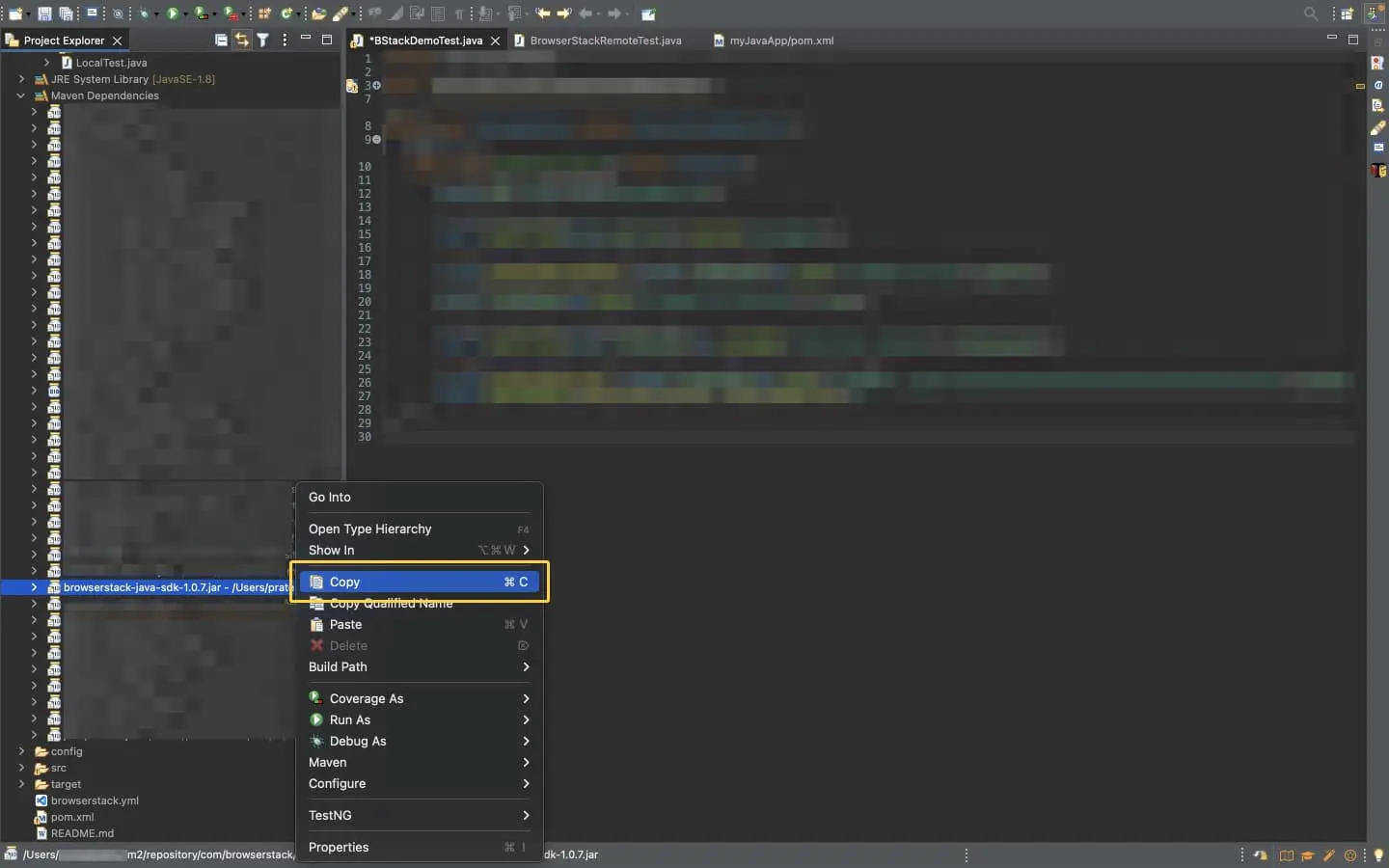
Example Paths:
Mac or Linux: /Users/User_Name/.m2/repository/com/browserstack/browserstack-java-sdk/1.0.9/browserstack-java-sdk-1.0.9.jar
Windows: C:\Users\User_Name\.m2\repository\com\browserstack\browserstack-java-sdk\1.0.9\browserstack-java-sdk-1.0.9.jar
Add browserstack-java-sdk .m2 repository path in VM arguments
In your test file, click on run icon & select run configurations:
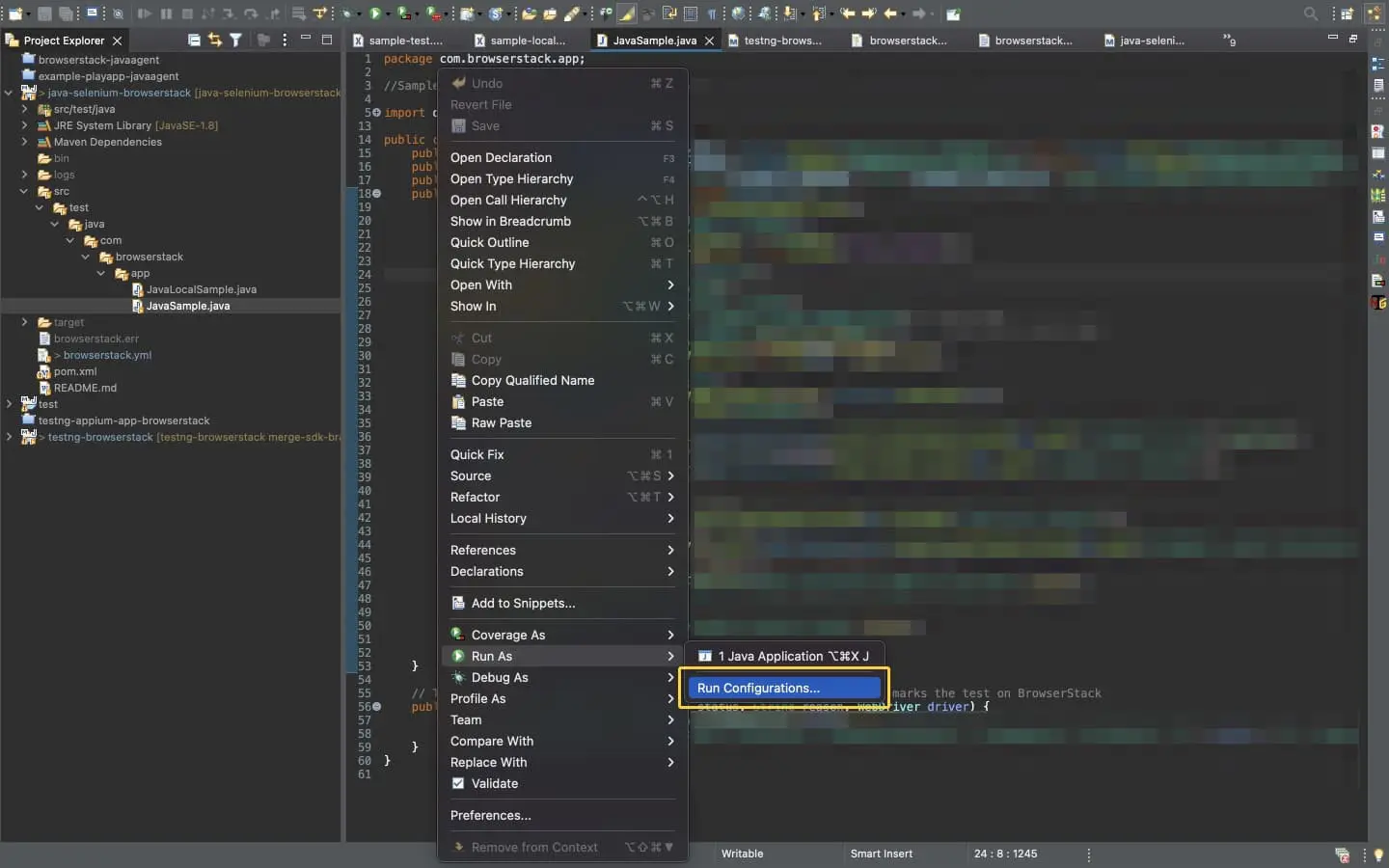
Click on Arguments pane & add the .m2 repository path in the VM arguments. Click Apply & then click Close:
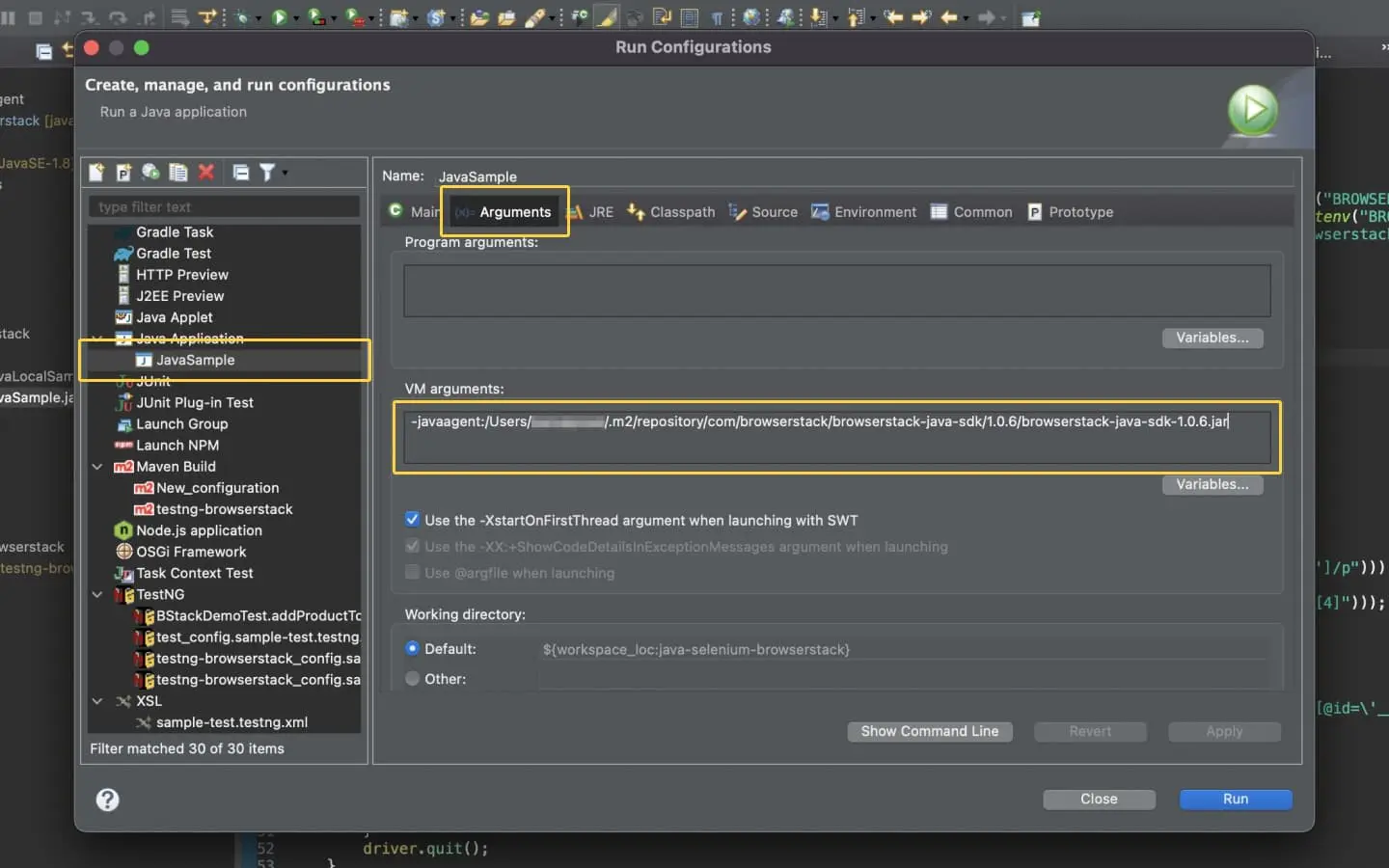
After successful completion of the above steps, you can now run your test suite using BrowserStack.
Set BrowserStack credentials
Saving your BrowserStack credentials as environment variables makes it easier to run your test suite from your local or CI environment.
Add BrowserStack SDK dependency
In your pom.xml file, add browserstack-java-sdk as a Maven dependency at the end of the dependencies list, within the <dependencies> element. Refresh the project.
If you are using the Surefire plugin to run tests, the steps to integrate might change. Check out framework-specific integration steps for TestNG.
Create your BrowserStack config file
After installing the SDK, create a browserstack.yml config file at the root level of your project. This file holds all the required capabilities to run tests on BrowserStack.
Set app to be tested
The app property determines the app to be tested. You can upload an Android app (.apk or .aab file) or an iOS app (.ipa file) from your local filesystem.
| Supported method | Description |
|---|---|
| path(Recommended) | SDK uploads the app using the specified relative or absolute path. Eg: app: ./SampleApp.apk. |
Check out how to create IPA files for iOS app testing on BrowserStack.
Other acceptable app property values
You can use BrowserStack REST API to upload your app.
Following is a sample response that is generated when you upload an app using any of the mentioned methods:
{
"app_url":"bs://f7c874f21852ba57957a3fdc33f47514288c4ba4",
"custom_id":"SampleApp",
"shareable_id":"exampleuser/SampleApp"
}
The following table explains the other acceptable app property values:
| Supported method | Description |
|---|---|
| app_url | Uploaded app’s app_url is a valid value for app property.Eg: app: bs://45e1c1473b17b7643aed1761f51cb5cdf3d3e334
|
| custom_id | If you’ve defined a custom_id while uploading your app, the same value can be used as app property value.Eg: app: CalculatorApp
|
| shareable_id | If you wish to test an app uploaded by someone else from your organization, a shareable_id can be used as the app property value.Eg: app: exampleuser/CalculatorApp
|
Check out how to specify the application under test to understand the above options better.
Set platforms to test on
Set the devices you want to test under the platforms object.
BrowserStack Reporting (part 1/2)
You can leverage BrowserStack’s extensive reporting features using the following capabilities:
| buildIdentifier | Description | Generated build name on BrowserStack dashboard |
|---|---|---|
| ${BUILD_NUMBER} (Default) | If build is triggered locally, an incremental counter is appended. If build is triggered with CI tools, CI generated build number is appended. |
bstack-demo 1 bstack-demo CI 1395 |
| ${DATE_TIME} | The timestamp of run time is appended to the build. | bstack-demo 29-Nov-20:44 |
Advanced use cases for Build Names
Custom formatting of build name
Prefix buildIdentifier with desired characters, for example, # or :
buildName: bstack-demo
buildIdentifier: '#${BUILD_NUMBER}'
Re-run tests in a build
You can re-run selected tests from a build using any of the following options:
Option 1: Set the existing build name in the BROWSERSTACK_BUILD_NAME variable and prepend it to your test run command to re-run tests in the same build:
BROWSERSTACK_BUILD_NAME="bstack-demo 1234" mvn test -P sample-test
Option 2: Set the build name as a combination of buildName and buildIdentifier, as seen on the dashboard, and set buildIdenitifier as null:
buildName: bstack-demo 123
buildIdentifier: null
Option 3: Set the buildIdentifier as the build number or time of the required build as seen on the dashboard:
buildName: bstack-demo
buildIdentifier: 123
Use additional debugging features
By default, BrowserStack provides prettified session logs, screenshots on every failed command, and a video of the entire test. Additionally, you can enable the following features:
Create browserstack.yml file
Create browserstack.yml file in the root folder of your test suite and add the code to it.
You can also pass regular expressions (regex) in deviceName and platformVersion capabilities if your device selection is more flexible. Check out how to use regular expressions to specify device attributes.
Use our Capability Generator to select from a comprehensive set of options you can use to customize your tests.
BrowserStack Reporting (part 2/2)
Test assertions are specific to selected language frameworks. BrowserStack requires explicit instruction to determine whether your tests have passed or failed based on the assertions in your test script.
Mark session name
You can use the sessionName capability to give your session a name (usually describing the test case) so that it is easy for you to debug later.
Mark test as passed or failed
To mark whether your test has passed or failed on BrowserStack, use the following Javascript executor in your test script.
The arguments passed in the Javascript method for setting the status and the corresponding reason of the test are status and reason
-
statusaccepts eitherpassedorfailedas the value -
reasonaccepts a value in string datatype
Run your test suite
Get browserstack-java-sdk .m2 repository path
Search for the browserstack-java-sdk jar in External Libraries. Right-click the .jar file, select Copy Path/References, and then copy the absolute path:
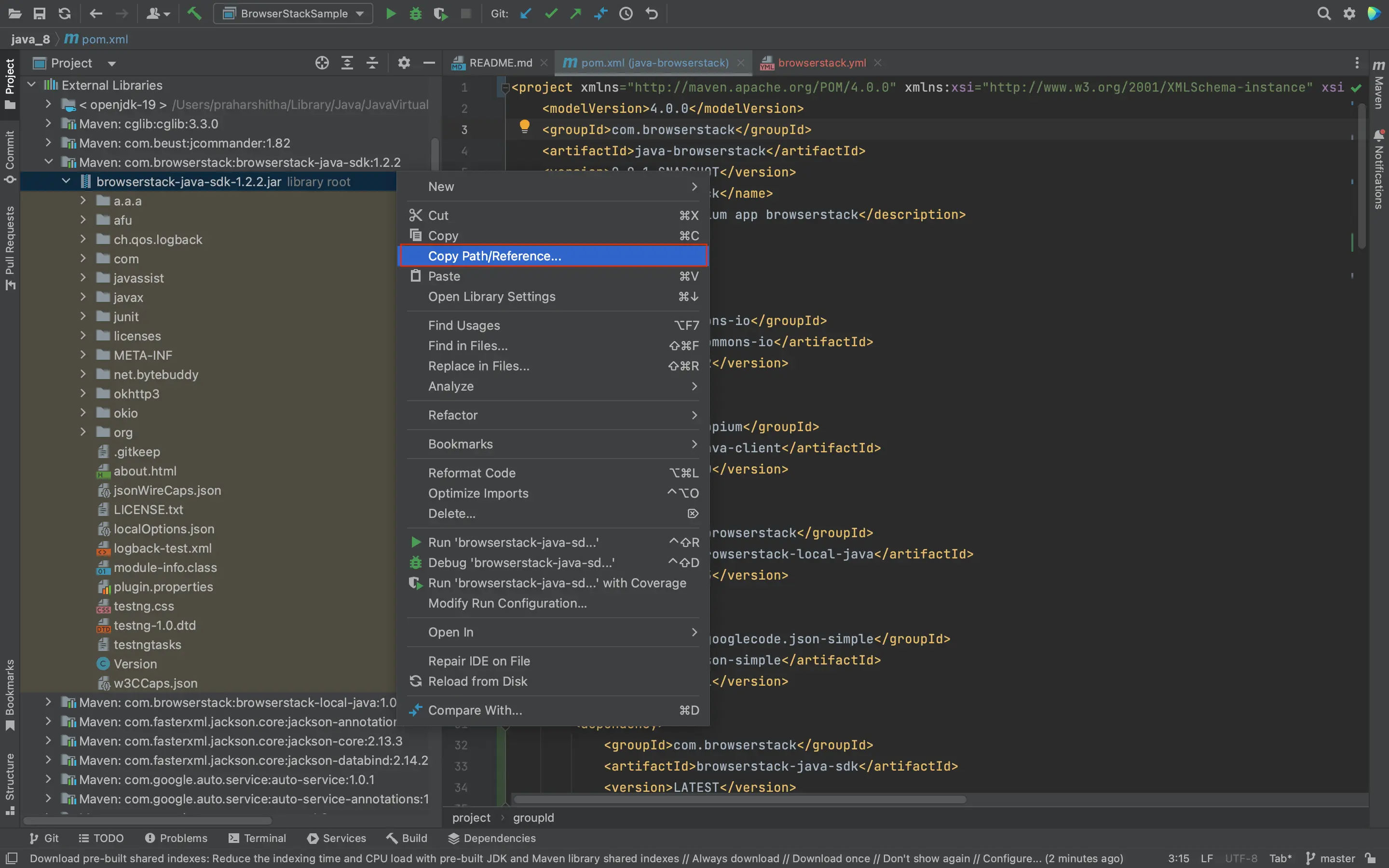
Example Paths:
Mac or Linux: /Users/User_Name/.m2/repository/com/browserstack/browserstack-java-sdk/1.0.9/browserstack-java-sdk-1.0.9.jar
Windows: C:\Users\User_Name\.m2\repository\com\browserstack\browserstack-java-sdk\1.0.9\browserstack-java-sdk-1.0.9.jar
Add browserstack-java-sdk .m2 repository path in VM arguments
In your test file, click on run icon & select Modify Run Configurations:
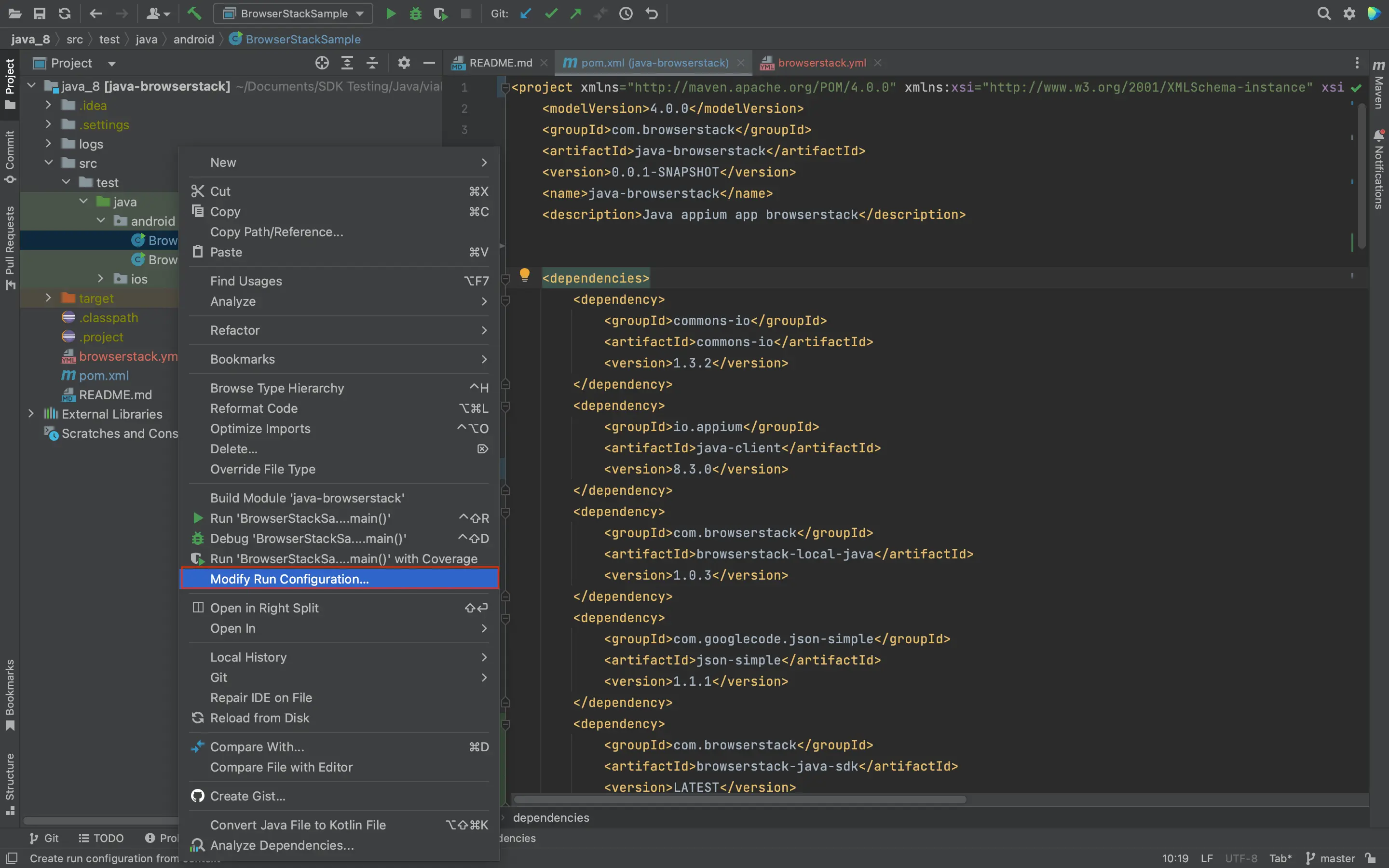
Click on Modify options:
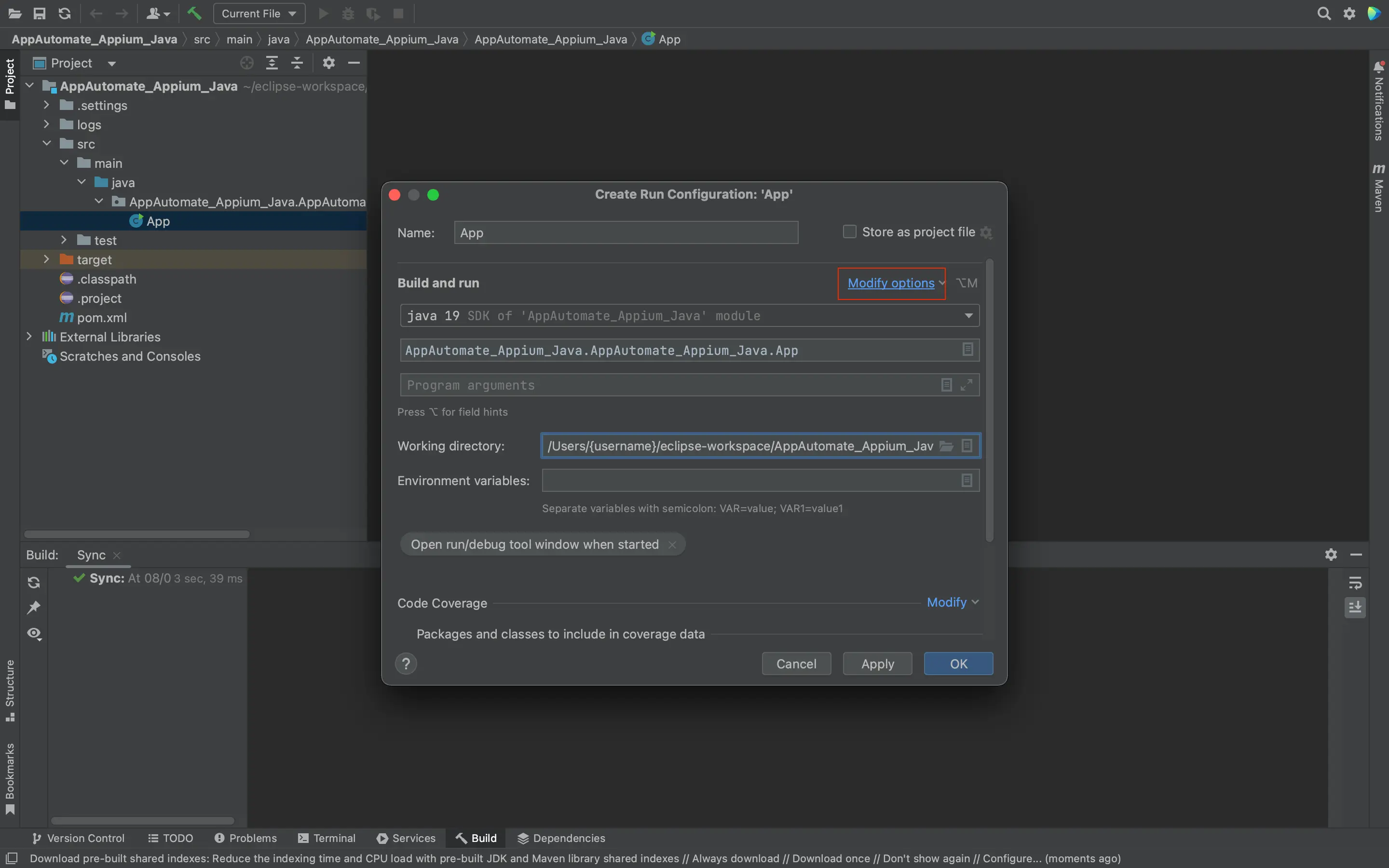
Click on Add VM options in the dropdown:
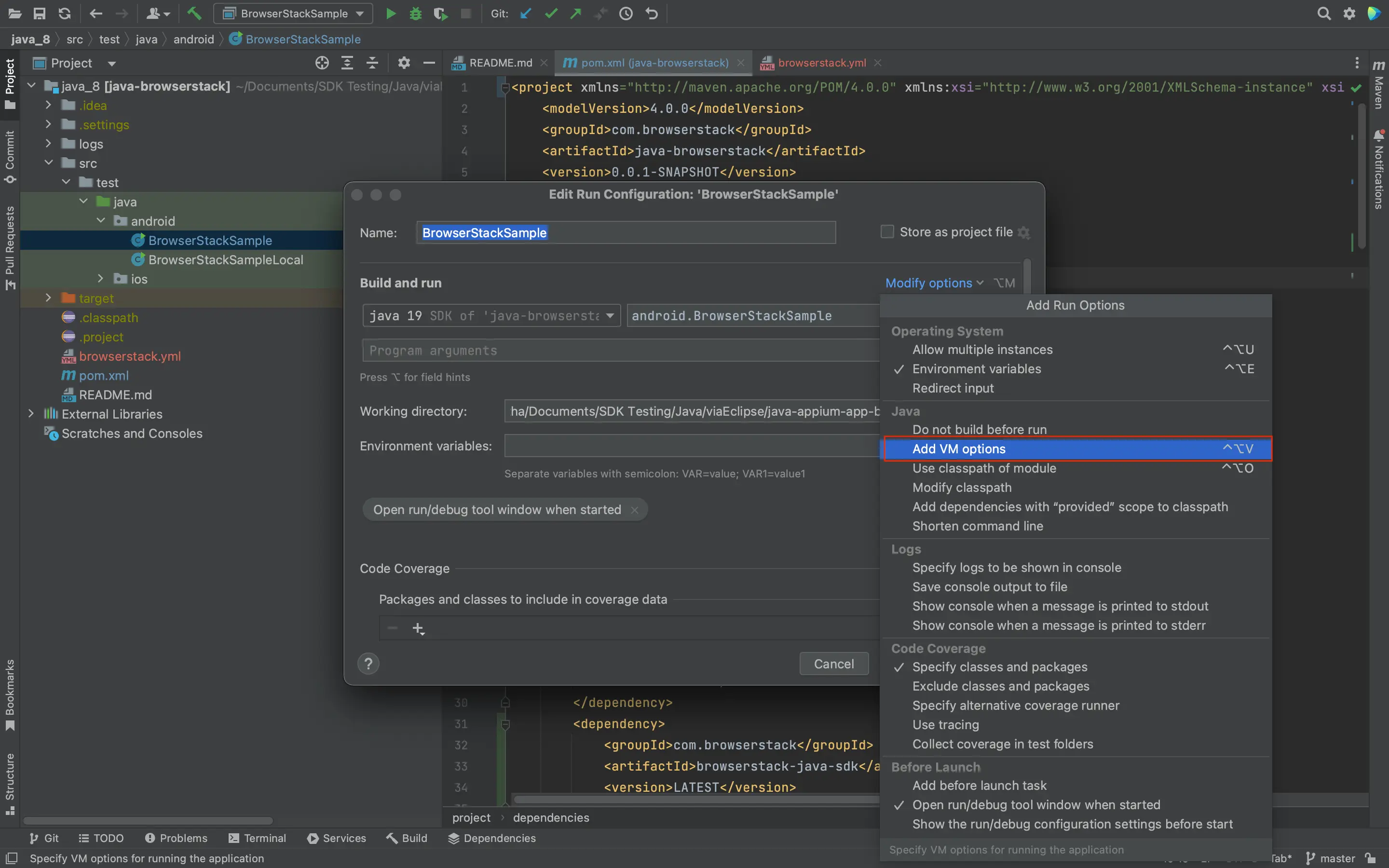
Add the .m2 repository path. Click OK :
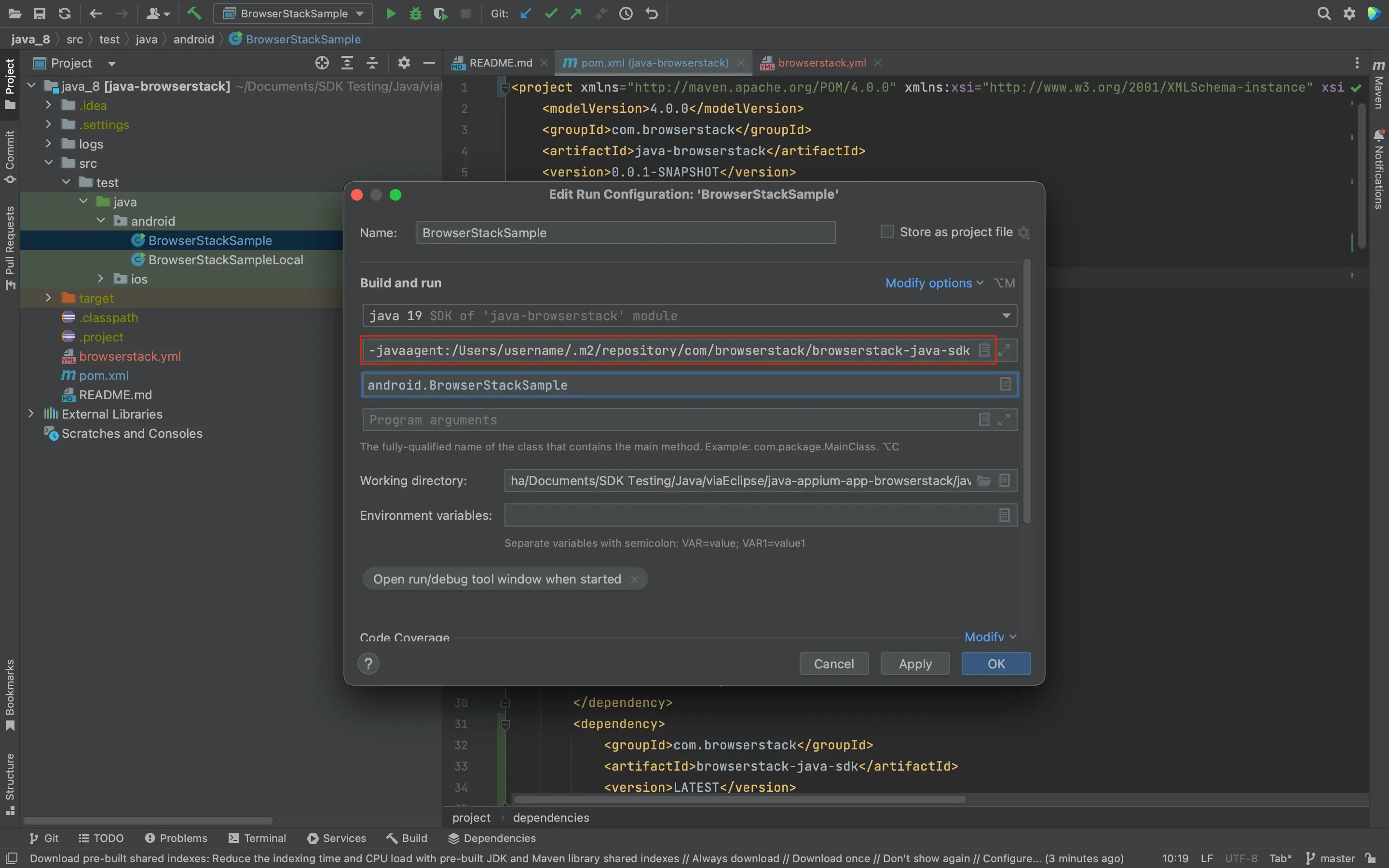
After successful completion of the above steps, you can now run your test suite using BrowserStack.
Set BrowserStack credentials
Saving your BrowserStack credentials as environment variables makes it easier to run your test suite from your local or CI environment.
Install BrowserStack SDK using Maven Archetype
Maven Archetype provides a template to quickly configure your project. Copy & run the below command on your terminal/command prompt to add browserstack-java-sdk dependency in your pom.xml and browserstack.yml config file in your project.
If you are using the Surefire plugin to run tests, the steps to integrate might change. Check out framework-specific integration steps for TestNG.
Create your BrowserStack config file
After installing the SDK, create a browserstack.yml config file at the root level of your project. This file holds all the required capabilities to run tests on BrowserStack.
Set app to be tested
The app property determines the app to be tested. You can upload an Android app (.apk or .aab file) or an iOS app (.ipa file) from your local filesystem.
| Supported method | Description |
|---|---|
| path(Recommended) | SDK uploads the app using the specified relative or absolute path. Eg: app: ./SampleApp.apk. |
Check out how to create IPA files for iOS app testing on BrowserStack.
Other acceptable app property values
You can use BrowserStack REST API to upload your app.
Following is a sample response that is generated when you upload an app using any of the mentioned methods:
{
"app_url":"bs://f7c874f21852ba57957a3fdc33f47514288c4ba4",
"custom_id":"SampleApp",
"shareable_id":"exampleuser/SampleApp"
}
The following table explains the other acceptable app property values:
| Supported method | Description |
|---|---|
| app_url | Uploaded app’s app_url is a valid value for app property.Eg: app: bs://45e1c1473b17b7643aed1761f51cb5cdf3d3e334
|
| custom_id | If you’ve defined a custom_id while uploading your app, the same value can be used as app property value.Eg: app: CalculatorApp
|
| shareable_id | If you wish to test an app uploaded by someone else from your organization, a shareable_id can be used as the app property value.Eg: app: exampleuser/CalculatorApp
|
Check out how to specify the application under test to understand the above options better.
Set platforms to test on
Set the devices you want to test under the platforms object.
BrowserStack Reporting (part 1/2)
You can leverage BrowserStack’s extensive reporting features using the following capabilities:
| buildIdentifier | Description | Generated build name on BrowserStack dashboard |
|---|---|---|
| ${BUILD_NUMBER} (Default) | If build is triggered locally, an incremental counter is appended. If build is triggered with CI tools, CI generated build number is appended. |
bstack-demo 1 bstack-demo CI 1395 |
| ${DATE_TIME} | The timestamp of run time is appended to the build. | bstack-demo 29-Nov-20:44 |
Advanced use cases for Build Names
Custom formatting of build name
Prefix buildIdentifier with desired characters, for example, # or :
buildName: bstack-demo
buildIdentifier: '#${BUILD_NUMBER}'
Re-run tests in a build
You can re-run selected tests from a build using any of the following options:
Option 1: Set the existing build name in the BROWSERSTACK_BUILD_NAME variable and prepend it to your test run command to re-run tests in the same build:
BROWSERSTACK_BUILD_NAME="bstack-demo 1234" mvn test -P sample-test
Option 2: Set the build name as a combination of buildName and buildIdentifier, as seen on the dashboard, and set buildIdenitifier as null:
buildName: bstack-demo 123
buildIdentifier: null
Option 3: Set the buildIdentifier as the build number or time of the required build as seen on the dashboard:
buildName: bstack-demo
buildIdentifier: 123
Use additional debugging features
By default, BrowserStack provides prettified session logs, screenshots on every failed command, and a video of the entire test. Additionally, you can enable the following features:
Create browserstack.yml file
Create browserstack.yml file in the root folder of your test suite and add the code to it.
You can also pass regular expressions (regex) in deviceName and platformVersion capabilities if your device selection is more flexible. Check out how to use regular expressions to specify device attributes.
Use our Capability Generator to select from a comprehensive set of options you can use to customize your tests.
BrowserStack Reporting (part 2/2)
Test assertions are specific to selected language frameworks. BrowserStack requires explicit instruction to determine whether your tests have passed or failed based on the assertions in your test script.
Mark session name
You can use the sessionName capability to give your session a name (usually describing the test case) so that it is easy for you to debug later.
Mark test as passed or failed
To mark whether your test has passed or failed on BrowserStack, use the following Javascript executor in your test script.
The arguments passed in the Javascript method for setting the status and the corresponding reason of the test are status and reason
-
statusaccepts eitherpassedorfailedas the value -
reasonaccepts a value in string datatype
Run your test suite
Modify exec command
Specify the .m2 repository path to browserstack-java-sdk.jar and update fully qualified name of your class file in the below command:
How to locate the .m2 repository path?
Search for the browserstack-java-sdk jar in Maven Dependencies, right-click the .jar file, and then click Copy:

Search for the browserstack-java-sdk jar in External Libraries. Right-click the .jar file, select Copy Path/References, and then copy the absolute path:

Example Paths:
Mac or Linux: /Users/User_Name/.m2/repository/com/browserstack/browserstack-java-sdk/1.0.9/browserstack-java-sdk-1.0.9.jar
Windows: C:\Users\User_Name\.m2\repository\com\browserstack\browserstack-java-sdk\1.0.9\browserstack-java-sdk-1.0.9.jar
Run tests
Run the modified mvn exec command in your Terminal/Command Prompt to execute the tests.
Note and save the updated exec command for running tests in the future.
After you run your test, visit the App Automate dashboard to view your test results.
Advanced features and use cases
Here’s a list of features and capabilities you may find useful.
Accept insecure certificates
The acceptInsecureCerts capability suppresses warning about self-signed certificates usually found in staging environments.
| Capability | Expected values |
|---|---|
acceptSslCerts |
A boolean. Default is False.True if you want to accept all SSL certificates. |
Change device orientation
The deviceOrientation capability changes the default mobile screen orientation for your tests on BrowserStack infra.
- If the parameter is set at the root level, its applicable to all the devices in the test.
- If you wish to apply it to a specific device, set it at the platform level which has the device details.
| Capability | Description | Expected values |
|---|---|---|
deviceOrientation |
Set the orientation of your app before beginning your test | A string. Default orientation is portrait. Supported orientations: portrait and landscape. |
Simulate IP geolocation
The geoLocation capability lets you test your app across different countries.
Note that this capability is supported on the Enterprise plan only. You can contact sales to get an Enterprise plan for your account.
| Capability | Description | Expected values |
|---|---|---|
geoLocation |
Set the country code you want your test to detect | A string. An ISO 2 country code FR for France, CN for China Check out the complete list of 45+ countries we support. |
Simulate network conditions
The networkProfile capability lets you test your app under different network conditions.
| Capability | Description | Expected values |
|---|---|---|
networkProfile |
Set the network profile to start the test with | A string. 2g-gprs-good, 4g-lte-advanced-lossy |
Others
Following are a few additional links to documentation pages that might help with your test scenarios:
Troubleshooting
Here’s a list of troubleshooting options you may find useful.
Resigned Apps and Third-Party Library Integration Issues
-
Uploading an unsigned version of an Android app will require us to sign it with our certificates before installing it on our devices. In the same manner, any uploaded .aab files will be converted into a universal APK and signed with our certificates.
-
If Browserstack resigns the apps, third-party library integrations such as Google Firebase services, Google Maps SDK, Facebook SDK, etc., may not function properly if the use of API keys is restricted based on the SHA-1 certificate fingerprint of the app’s signing key.
-
To prevent this issue, it’s recommended to sign the APK with your own certificates before uploading it to BrowserStack.
Disabling Re-Signing for iOS Apps
- If you upload an iOS app, we will re-sign the app with our own provisioning profile to be able to install your app on our devices during test execution.
- However, if your app is signed using the Apple Developer Enterprise Program, you can disable this behavior to test features such as push notifications on BrowserStack devices.
| Capability | Expected values |
|---|---|
resignApp |
A boolean. To disable re-signing, set the browserstack.resignApp capability to false in your Appium test scripts. |
Next steps
Once you have successfully integrated your test suite with BrowserStack, you might want to check the following:
- Generate a list of capabilities that you want to use in tests
- Find information about your Projects, Builds and Sessions using our REST APIs
- Set up your CI/CD: Jenkins, Bamboo, TeamCity, Azure, CircleCI, TravisCI.
We're sorry to hear that. Please share your feedback so we can do better
Contact our Support team for immediate help while we work on improving our docs.
We're continuously improving our docs. We'd love to know what you liked
We're sorry to hear that. Please share your feedback so we can do better
Contact our Support team for immediate help while we work on improving our docs.
We're continuously improving our docs. We'd love to know what you liked
Thank you for your valuable feedback!





